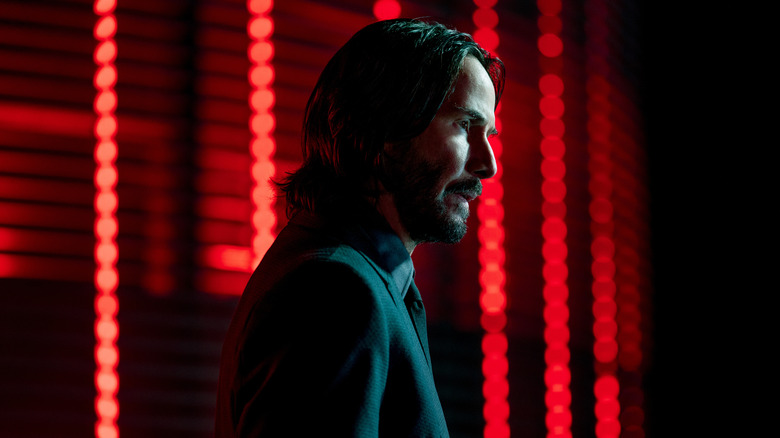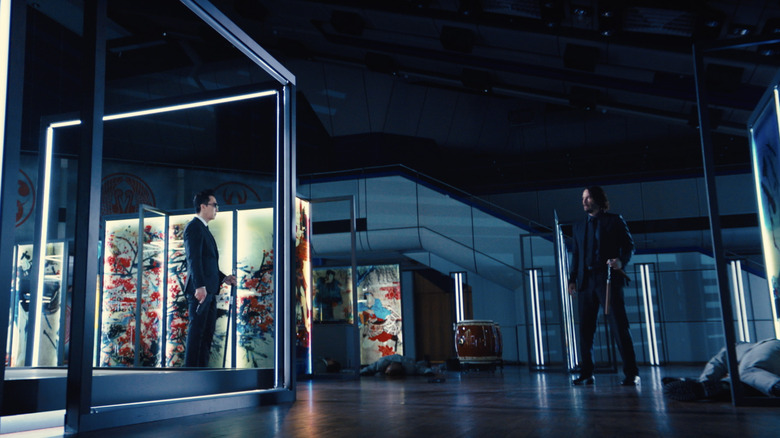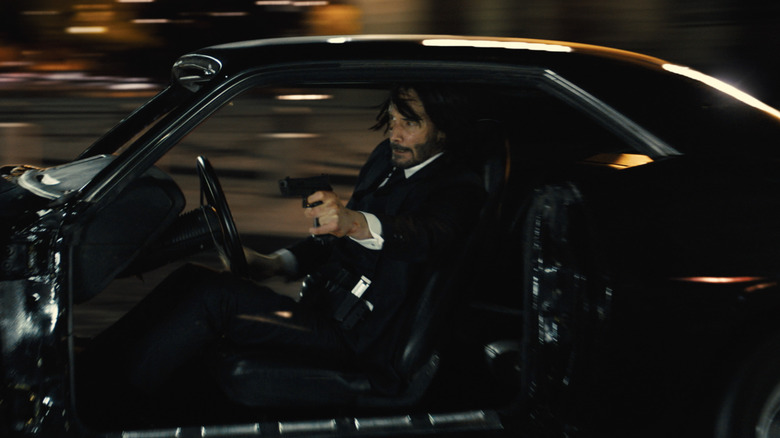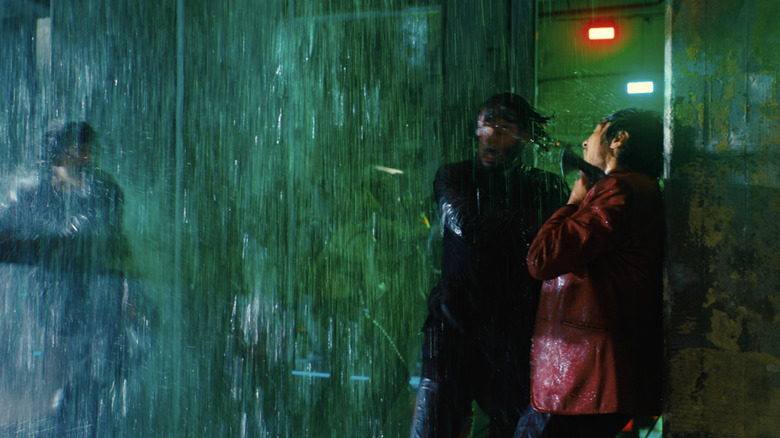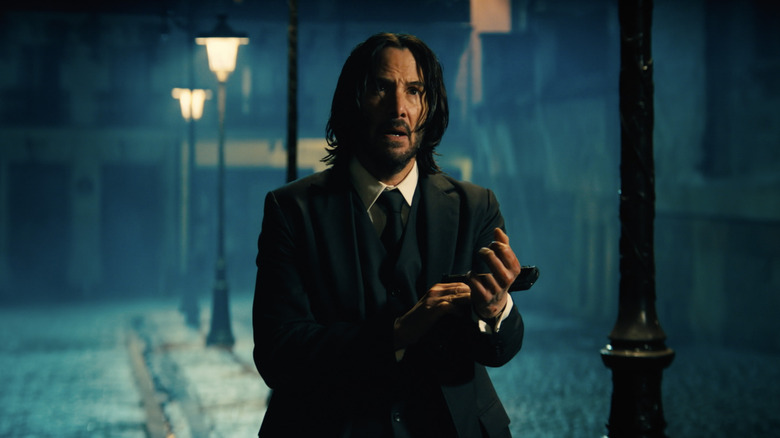The John Wick 4 Sound Team On Crafting The Soundtrack Of Headshots And Crunching Bones [Exclusive Interview]
Movies are just as much an aural experience as they are a visual one. Just imagine watching a "Star Wars" movie without the sound of a TIE Fighter whooshing by, or a lightsaber igniting. Or think about watching Michael Mann's "Heat" without the deafening gunshots during the bank heist. Sound can make a movie or break a movie. That's something that the team behind the "John Wick" movies absolutely understand, as an awful lot goes into crafting all of those headshots and broken bones. And audiences are treated to nearly three hours of it in "John Wick: Chapter 4."
The film is full of staples that have been established in the series: gun-fu, hand-to-hand combat, and lots of breakage in the surrounding environment. The men responsible for making all of this carnage sound real and cinematic in "Chapter 4" were Mark Stoeckinger, the film's supervising sound editor, as well as re-recording mixers Casey Genton and Andy Koyama. Granted, the sound team on a film is large and there are many moving pieces, but Stoeckinger largely helped craft what we hear when Keanu Reeves fires a gun, or when a nunchuck cracks a man's bones.
I had the good fortune of speaking with Stoekinger, Genton, and Koyama in honor of the film's release in theaters. We discussed what it takes to make each headshot sound unique, how they differentiate John Wick's guns from everyone else, how complicated it was getting that night club scene just right, and much more.
Note: This interview has been lightly edited for clarity and brevity.
'We sort of shaped the emotion of the soundtrack'
I think most people know what a director does and most people know what an actor does, but how would you guys describe your jobs to people who have no idea what it is you do?
Stoeckinger: I think on a very global level, you understand what movie the director is trying to make, and you support him or her through the use of what your lane is, the sound that you make into the soundtrack. That's kind of the big picture, and then you can drill down on that one, but you're really there to support the director, and the film, and the story. Obviously there's a lot of granular aspects to that one. That's the big picture explanation.
Casey and Andrew, how do you guys factor into the picture there?
Koyama: Casey and I are the re-recording sound mixers. We sit on the stage during and do the final sound balancing between dialogue, music, sound effects. There's a whole bunch of pre-mix mixing that happens before we hit the stage. So we get our dialogue and the sound effects organized and balanced within themselves, respectively. Then as a group — the supervising sound editor, Mark, the effects mixer, Casey, I do dialogue and music, the picture editor and director on the stage — in collaboration, we balance all those sounds together to make the final master.
Stoeckinger: I would say what Andy and Casey do, they focus the story. They've focused the story as to what you're supposed to hear and how you're supposed to hear it.
Genton: Yeah, exactly. We sort of shaped the emotion of the soundtrack in that balancing and the decisions that we make and help further some of the ideas or make ideas more clear through the mix.
Focusing a bit more specifically on "John Wick: Chapter 4," apparently the original cut was around four hours. How much of the sound work that you guys did actually wound up on the cutting room floor?
Stoeckinger: Each film is made in unique ways, and "John Wick 4" was made in unique ways. As far as the sound work that we did that ended up on the cutting room floor, we came in at various stages. As far as contributing sounds and making sounds for the picture editor and their assistant team to utilize in making the sound work within their Avid editing, and ultimately their preview, that is something they really controlled.
Frequently, we might be involved earlier on and do mixes and do some sound design work that eventually matriculates itself into the final mix. But on this one, it was really a lot of content providing along the way. By the time we were going to make the full press into the soundtrack of the film, it was fairly decided on what the cut of the film was going to be. Things changed along the way, but nothing, and particularly in this film, nothing of significance that was done that got left behind. Some scenes got left behind before we really got heavily involved. There's only two scenes I can think of that I saw in the whole movie that got left behind.
Oh, okay. Wow.
Stoeckinger: Yeah.
'It's an intricate dance to make everything play properly'
One thing that is consistent throughout the John Wick movies is lots and lots of headshots. At this point, do you guys just have an in the can sound for a headshot, or do you treat each one of these headshots as its own unique thing?
Stoeckinger: They're all their own unique thing. And the sounds that contribute to that have evolved throughout the "John Wick" franchise, for sure. That is part of what "John Wick" is all about. So it is about a lot of detail and the headshots are part of that detail. There's probably, between the shot, and the hit, and the heads and all, there's probably 12 to 15 sounds that make up that event.
Genton: And they are all different, too. Some of them are a little more impactful and bone crunchy, and some of them are a little more splatty, they have a little bit of spray on them or blood spill. It's those kinds of subtle details that I think make those moments in the "Wick" movies a standout element, that it's not the same thing every time. It certainly isn't canned and it's kind of a bespoke head explosion for each one.
Stoeckinger: One thing I'll say about it, too, when you put the sounds together, you can't just use a gunshot because it's so simple. You can't just put the sound out of a gunshot in, it goes "bang," and it tails off. But frequently you've got other sounds coming up. If you didn't just truncate it to maybe just a couple frames long, if that's what it needs to be, then it's just mushy. So if you listen to sounds on their own outside of the mix individually, they might all sound cut up and disjointed, but once put together into the soundtrack, the goal is not to sound that way.
Oh, okay.
Stoeckinger: The old school way is if you have three gunshots in a row to put a blank frame between each gunshot, so when the next one happens, it's got a clean beginning, as an example. There's all sorts of sounds throughout the entire movie, and not just guns, that follow that motif to just keep it clean and detailed.
Genton: That's right.
Stoeckinger: It'd be like a bunch of overlapping dialogue if you didn't do things that way. You couldn't really always understand what people are saying.
Koyama: Yeah, it's an intricate dance to make everything play properly. It takes a lot of time and effort and collaboration from all departments.
Genton: Totally.
As the actual gunshot sounds go, how do you get to the many different gunshot sounds you might need? Are you just going to a firing range and grabbing a bunch of gunshots? How is it that you guys are crafting that stuff?
Stoeckinger: Ultimately, we're fortunate in that we're a large group of creative people who've done a lot of recording here. So there's a lot of recordings of all sorts of different guns. And like you said, they all tend to sound different. When I say there might be 12 to 15 sounds in a gunshot, that's because there's multiple layers. There's some gun recordings that are fairly sharp and there's others that are kind of boomy, others might be roomy, others that are just low wind. Depending on what you want to do, you layer them specifically together, and you've got to have them almost lined up to the sample or else you'll just kind of ruin the sound. Amongst the gunshots, there's a little bit of sound of mechanism in each one of them, which typically doesn't stand out, but it's there, and you'd miss it if it wasn't there. Sometimes there's just a little frequency.
Genton: Little things that you don't realize that you'd miss if they were gone, but they do add an element to the gun, each gunshot that makes it feel different than the gunshot before it, or the other gun that someone else is firing. It's details like that, that aren't sort of at the forefront of the sound, but that are layered in that make all of these guns sound different.
Stoeckinger: Right, and then Casey's changing the balance, and the EQ, and the compression on each one, and the reverb on them. So they're always different. It doesn't sound like a loop of a gunshot in any case. And that's real daunting and very time-consuming.
'His gun's kind of got to be bigger than everybody else'
I don't want to get super-duper specific, but there is one gun that I think people are going to talk about for quite some time, and that's toward the end of the movie. You have that climax where there is the explosive shotgun that Wick gets his hands on, and that has a really unique sound to it. How hard was it to nail down that one in the mix?
Genton: I think that, visually, it offers pretty much everything you need to match sonically. It's a gun that basically is an explosive fire bomb when it hits its target, and even when it's launching. Alan Rankin, who does a lot of the weapons for the "Wick" movies, he's such a brilliant sound designer, and he put — in that gun in particular, there were so many unique, not normal sounds that he used particularly. One I thought was really cool, you may not catch it, but it's there subtly when the flames are traveling, there's this really cool — the best way I can describe it is a rocket whir or something. It's this high-pitched woo, when it goes flying by, that just adds movement and depth to the event. So he really layered in a lot of stuff that I think is not normal to the gun sort of weapon world that makes that whole thing really unique.
Stoeckinger: I think we all feel that your ear really grabs on anything that changes pitch, even if it's a short little sound. There's a lot of really talented people who have done a lot of films, a lot of different recordings. There's somebody here who's an amateur pyro technician. He does all the "Fast and Furious" movies as a side hobby. I was showing it to him and I said, "I really like that sound like when you make the fireworks and it has that after-crackle." I'm a novice trying to explain it, and he goes, "Oh yeah, you want some meesh metal." Of course he records everything he does, so that's one of the elements in there, that kind of staticky crackle at the end of fireworks because somebody helped me identify what it was, we got that sound, and is one of the pallet of sounds in that shotgun. The real one doesn't sound anything like that when we filmed it. It's like what you do for dramatics. You just make it interesting.
Genton: I think when it comes to Wick firing a gun, his gun's kind of got to be bigger than everybody else. So even in that scene when people are shooting shotguns and he's got this sort of a variation of a shotgun, his shotgun's always got to be bigger. So that gun stands out I think amongst other guns in that way, for sure.
Stoeckinger: We say that Wick's always picking up somebody else's gun, and there's a bunch of different elements to make the gun. So it might sound one way when somebody else has it, but when Wick has it, it might get a little bit more low frequency or it might get a little bit bigger just to accentuate a little bit more, even though it still pretty much sounds like the bad guy when he had it, but it's just a little bit more, something's a little bit more in this movie.
You also have some other unique weapons in this movie. How does the sound of a nunchuck cracking a guy's bones differ from when you have a guy just punching someone and cracking a guy's bones? How nuanced do you have to get when making those decisions?
Stoeckinger: Well, one's sharper, more solid than the other. Is that a good start, Casey?
Genton: I think what would differentiate those things is when we're putting together the sound for those types of events, it's always trying to accentuate the thing that's most painful or whatever sells. Not only the thing that they're using, that they're getting hit by whoever, whatever they're getting hit by, but also what happens to that person when it's hit by it.
So for instance, with the wood nunchuck hitting a skull, there's a sound that we can all imagine what it would be like to get hit with a piece of solid wood like that on your head. That's the element that we're leaning into more than anything when he's getting hit with a nu chuck versus when Wick is punching somebody. It's really more about the contact of a fist and then the residual detail of whatever it is that is breaking or crushing. It could be a rib, it could be your nose, it could be teeth cracking when they get hit in the face or whatever.
Stoeckinger: You'll notice in this movie that when we've grabbed somebody or whatever, that just sounds like anybody doing something like that. But when he hits somebody, typically it's in a stylistic moment. So that gave the opportunity to be much broader, obviously over the top. I'm thinking of the Killa scenes as an example. As Casey will tell you, that's an homage to the original hits to the beginning of the movie. But when you do hits, there's little sounds in there. Again, you might not notice altogether, but you might notice their absence. There's like little wishy sounds before the hit just to give velocity. A nunchuck might have a higher-pitched, faster wishy sound than a hit. So those are some of the nuances that just all contribute to it.
'Everybody who was part of that movie was excited about doing it again'
I think one of the scenes that stands out in this movie is nightclub scene. There is so much noise going on in that scene. There's waterfalls everywhere, there's people dancing, there's music, there's gunshots. How hard was it sort of balancing everything in that scene that you guys had to manage?
Koyama: Music is definitely the primary driver. We wanted it to feel like you're in one of those huge techno nightclubs and the bass is rattling you. The cool thing is that we had, I believe it was the pitch editors sourced some cool, original material from artists from Europe. There's a guy named Dylan Island. He did remixes of himself out of his original material specifically for us to use. I tried something, I was maybe a little technical. I was using this plugin called Indoor, which simulates interior spaces. I did a parallel process where I had the song and then this Indoor treatment, and putting them together, amplifying the bass and trying to make it feel like we were right beside these 18 inch speakers.
That's so cool. My first degree was actually in audio engineering, so that actually registers for me.
Stoeckinger: But it's really, really big, yet it's not in the way of anything.
Right.
Stoeckinger: It's just amazing that it plays that way. And has filter sweeps and all sorts of stuff going on in there.
Genton: Yeah. And I don't want to speak out of turn here, but Andy, to my memory, I thought that reel kind of came together pretty quickly for how detailed and crazy the elements were.
Koyama: It was the one we always played for people. We wanted to impress them when they came.
Stoeckinger: It was a showcase reel, for sure.
I once heard Eli Roth talk about smashing a wet bag of chicken bones to make the sound of bones crushing in one of his movies or something. What is the weirdest thing you guys actually used or can remember using in this movie to make a noise you needed to make?
Stoeckinger: That's a really good question. Not specifically for this movie, but over the course of time before this movie, there's a lot of vegetables that gave up their lives for cinema.
Koyama: Yeah. A funny story of this is, not on this film, but some foley artists were using a chicken for just that and then they lost it on the foley stage.
Stoeckinger: Oh!
Koyama: About a week later, it was the most horrible smell.
Oh! That's disgusting.
Stoeckinger: Yeah, I can't think of anything that's really completely out there for this movie that was used to make a sound. But obviously, over the course of all of our careers here, there's been all sorts of crazy stuff that's made sounds. Sometimes it's the stuff or the microphones you record it with so you can record something with a really real, as you know, from recording off a very high sample rate microphone, then you can slow it down a lot. You don't get artifacts and you get sounds that you never even knew existed when you do that. Or you use contact mics on something that pick up resonances or whatever that you would never otherwise hear. It's kind of fun playing around. What's nice about feature films too, because you do usually have a chance to play a little bit to come up with something unique.
If I can ask a couple of tiny off-topic questions. Mark, I've noticed you've done quite a bit of work for Mr. Ridley Scott over the years and it looks like "Gladiator 2" is coming together. Are you going to go back in for that one?
Stoeckinger: No, I mean, I've really only worked on two Ridley Scott films, "Robin Hood" and "Prometheus." He actually does all his work in England now. No, I am not going to be a part of that one. That would be awesome. But it's just, it's not here.
I know you also did "Nobody," if I'm not mistaken, and I know there's been a little bit of talk about a sequel for that. Have you heard anything about that? Do you know if they're going to actually end up doing that?
Stoeckinger: I don't know, but I do know that they're talking about it. That is a producer/director team that have this franchise, David [Leitch] and Kelly [McCormick]. I know they're excited about doing that. I know that everybody who was part of that movie was excited about doing it again. I think it really established Bob Odenkirk as somebody who can really carry off those action beats really, really well and convincingly. And he's really dedicated.
Totally.
Stoeckinger: He trained for a long time for that movie. I'm sure he doesn't want to give it up for whatever might come next.
Andy, I noticed, are you working on "Rebel Moon." Are you doing the Zack Snyder flick?
Koyama: We just did the first temp mix for the preview of part one, and it's very exciting. It's a big, huge, space — they probably don't want me to say this — 'Star Wars'-y, 'rebels against the evil empire' thing over all sorts of different worlds. It's really fun. There's going to be two films. I think we're mixing that from June to February. And there's also going to be extended R-rated versions of each of the two films, so we're going to be mixing four different features.
Holy crap. That's crazy.
Stoeckinger: Yeah, it's going to be crazy. It's a good job.
Casey, last thing for you, if I, did I see correctly, did you work on the "Toxic Avenger" reboot?
Genton: I did, yeah.
Oh my God. Can you say anything about that?
Genton: Yeah, I mean, any questions that you have, I'd be happy to answer. It's a really funny movie. Macon Blair, the director, I think did a really good job with it. Everybody was a dream on the film. I'm so surprised because for me personally, I had not seen the original "Toxic Avenger" until I had done this film. It's a huge cult classic, and I know people are really excited about it. When they have tested it, fans of the film have been over the moon with the film.
That's awesome. Having seen the original before going into it, is it sort of tonally similar, or are they kind of taking a bit of a different crack at it?
Genton: It's pretty out there. It's pretty funny. I think it's a different crack, I would say, this one. They're giving the fans what they want, for sure. There's no lack of — I know everybody references the little kid's head getting run over and stuff. I think that there was an iteration of [this] film that didn't have enough of that, so they made a very — I don't want to ruin it. But it's been nicknamed the "butt guts" scene and it's probably the best sort of way to match that 'head getting run over' energy that everybody's looking for. So it's in line with the fan base, and I think it's hilarious.
"John Wick: Chapter 4" is in theaters now.
